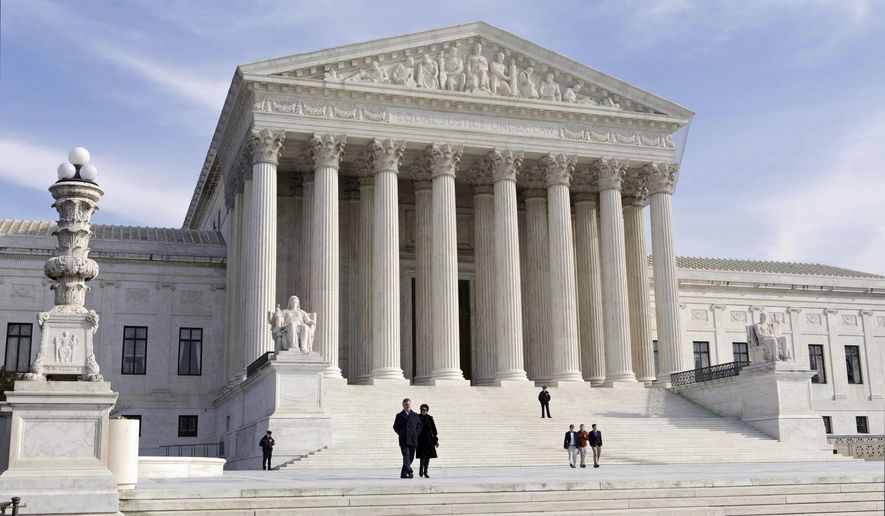The Supreme Court is preparing to wade into one of the most politically charged cases in years, hearing oral arguments early next month on just how much of a role partisanship can play when states are drawing congressional and state legislative district maps.
The justices have long accepted partisanship as a part of the process, but as states become more creative in protecting one party or the other, opponents are demanding the courts to step in and put a stop to it.
That would force the justices to decide how much partisanship is too much.
“This is by far the most important case in two years, and since gerrymandering is the biggest threat to democracy, it is of incredible significance,” said Lucas Powe, a law professor at the University of Texas.
The case to come before the court involves Wisconsin’s General Assembly map, drawn in 2011 by Republicans who controlled the assembly and thus the redistricting process. In the 2012 election, Democrats received 53 percent of the vote in assembly elections but won just 39 of the 99 seats.
A lower court struck down the state’s districting, concluding it was too partisan.
The Supreme Court has said extreme partisanship, denying voters a fair chance to pick their representatives, was illegal. But it struggled to figure out how to determine whether a district map crossed that line.
Court watchers say four conservative-leaning justices are likely to side with Wisconsin and four liberal-leaning justices will almost certainly find the state map illegal.
That would once again leave Justice Anthony M. Kennedy as the decider.
Justice Kennedy “believes that the federal courts should hear partisan gerrymander cases, but he has yet to be presented with a workable standard for resolving these cases,” said Joe Kanefield, an election lawyer for Ballard Spahr LLP.
If Justice Kennedy is searching for a method, then the three-judge panel that first ruled Wisconsin’s map illegal could provide him with a workable formula.
That court used a measure known as the “efficiency gap” to look at how Democratic voters were packed into districts, piling up massive wins for their candidates, while Republicans were spread more evenly, providing smaller margins of victory but in far more districts.
Mathematicians calculated how many votes Democrats “wasted” by being packed into districts by looking at how many votes a political party needs to elect its candidate and how many votes that candidate receives. If the candidate wins by significantly more votes than what is needed, then it suggests the congressional district has been drawn with extreme partisanship in mind.
“We acknowledge that the expert opinions in this case have persuaded us that, on the facts before us, the [efficiency gap] is corroborative evidence of an aggressive partisan gerrymander that was both intended and likely to persist for the life of the plan,” Circuit Judge Kenneth Ripple wrote in his opinion for the lower court.
Wisconsin, though, says the efficiency gap is an inexact way of looking at voting districts and warned that accepting it as a measure of partisanship would open a door to massive judicial intervention in politics.
Any “displeased voter” could file a federal lawsuit challenging maps based on a “social science hodgepodge” of theories to try to redraw the lines, the state argued in its brief to the Supreme Court.
Wisconsin clearly had Justice Kennedy in mind, pointing to his concurring opinion years ago when the court grappled with the same issue, finding that partisan gerrymandering could be illegal. But justices were unable to agree on a standard.
“It has been more than three decades since Davis v. Bandemer and yet no party or court has identified any ’comprehensive and neutral principles for drawing electoral boundaries,’ let alone a limited and precise test to enforce those principles,” Wisconsin said.
Mark Jones, a professor at Rice University, said using a uniform mathematical standard to determine partisan gerrymandering is difficult because it fluctuates based on a variety of factors.
He said different efficiency gaps can be derived depending on which election data are evaluated and that the efficiency gap calculation makes the assumption people vote based purely on their partisan affiliation. Mr. Jones also said it doesn’t address what to do with districts where seats are uncontested.
“The dilemma that’s always faced the courts is trying to figure out where you draw the line and how do you do it in a reliable manner such [that] you can apply it across different cases and different states,” said Mr. Jones. “And I don’t think the efficiency gap measure meets that standard — that is, it’s too variable.”
If the Supreme Court rejects the “efficiency gap” test, then the case will go back to the lower courts to try to derive another formula.
But if the justices approve the “efficiency gap” standard by affirming the lower court’s ruling, then it could ripple across the country and strike down perhaps one-third of all maps, Wisconsin said.
“If the court articulates a standard for identifying unconstitutional partisan gerrymanders, it would probably apply to every place where representative districts are drawn. It’s one of the reasons the court has tread so lightly in this area,” said Derek Muller, a law professor at Pepperdine University.
• Alex Swoyer can be reached at aswoyer@washingtontimes.com.




Please read our comment policy before commenting.